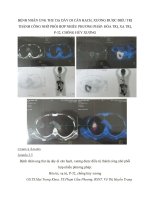- Trang chủ >>
- Y - Dược >>
- Ngoại khoa
U nguyên bào di căn não, gan và phổi được điều trị thành công_Tiếng Anh
Bạn đang xem bản rút gọn của tài liệu. Xem và tải ngay bản đầy đủ của tài liệu tại đây (602.69 KB, 19 trang )
<span class='text_page_counter'>(1)</span><div class='page_container' data-page=1>
Gestational trophoblastic
neoplasia with celebral
and hepatic metastasis:
a case report
</div>
<span class='text_page_counter'>(2)</span><div class='page_container' data-page=2>
Introduction
• GTN is a malignant disease, mostly arises
after molar pregnancy
• The rate of molar 1/650 pregnancy,
15-20% becomes GTN after molar
</div>
<span class='text_page_counter'>(3)</span><div class='page_container' data-page=3>
Introduction
• GTN with metastasis 15%
• Sites of metastasis: lung, vagina, brain,
liver
</div>
<span class='text_page_counter'>(4)</span><div class='page_container' data-page=4>
FIGO risk score
<b>Risk factor </b>
<b>Score </b>
0 1 2 4
Age <40 >40
Antecedant P mole abortion Term P
Intrval P-chemo <4 4-7 7-13 >13
hCG <103 <sub>10</sub>3 <sub> -10</sub>4<sub> 10</sub>4 <sub> - 10</sub>5 <sub>>10</sub>5
Largest tumour
size
3-5 >5
Site metastasis Lung Spleen,
kidney
gastro Brain,
liver
Number metastasis 1-4 5-8 >8
Pre chemo mono combin
</div>
<span class='text_page_counter'>(5)</span><div class='page_container' data-page=5>
Background
• Low risk group <7 points: mono
chemotherapy MTX/FA
</div>
<span class='text_page_counter'>(6)</span><div class='page_container' data-page=6>
Case report
• Female patient, 36 y-o, in Hanoi
• Antecedant pregnancy: 3 term-deliveries,
last pregnancy 8 months (term delivery)
</div>
<span class='text_page_counter'>(7)</span><div class='page_container' data-page=7>
Case report
• Neuro signes: vomiting, headache,
temporary blind
• Local signes: enlarged uterus, no vaginal
metastasis, no ovarian cyst-theca lutein
cysts
• β hCG: 32783 UI/l
</div>
<span class='text_page_counter'>(8)</span><div class='page_container' data-page=8>
Case report
• Abdo MRI: metastasis in liver
• hCG dosage cerebrospinal fluid
<b>1 </b>
<b>2 </b>
<b>3 </b>
<b>4 </b>
</div>
<span class='text_page_counter'>(9)</span><div class='page_container' data-page=9>
Case report
• Diagnosis: GTN high risk, FIGO 15 points
• Treatment: multi-paradigm
Chemotherapy: EMACO
Surgery: hysterectomy, liver
Symptom: manitol 10%
Radiotherapy: if necessary
</div>
<span class='text_page_counter'>(10)</span><div class='page_container' data-page=10>
Case report
• EMACO:
Etoposide 100mg/m2
MTX 100 mg/m2 bolus, 200mg/m2 IV
ActinomycinD 0,5mg
</div>
<span class='text_page_counter'>(11)</span><div class='page_container' data-page=11>
Case report
</div>
<span class='text_page_counter'>(12)</span><div class='page_container' data-page=12>
Case report
• Day 3: hemorrhage peritoneal due to
rupture hepatic metastasis
</div>
<span class='text_page_counter'>(13)</span><div class='page_container' data-page=13>
Case report
• Neuro signes: improved
• hCG declined
<b>21/2/2018 </b> <b>2/3/2018 </b> <b>15/3/2018 </b> <b>29/3/2018 </b> <b>12/4/2018 </b> <b>23/4/2018 </b>
</div>
<span class='text_page_counter'>(14)</span><div class='page_container' data-page=14>
Discussion
• Diagnosis of GTN: menometrorrhagia,
high dosage of βhCG postpartum
• Diagnosis of metastatic site: MRI, chest
Xray, spinal fluids, biopsy
• Treatment: multi-paradigm
</div>
<span class='text_page_counter'>(15)</span><div class='page_container' data-page=15></div>
<span class='text_page_counter'>(16)</span><div class='page_container' data-page=16></div>
<span class='text_page_counter'>(17)</span><div class='page_container' data-page=17></div>
<span class='text_page_counter'>(18)</span><div class='page_container' data-page=18></div>
<span class='text_page_counter'>(19)</span><div class='page_container' data-page=19></div>
<!--links-->









